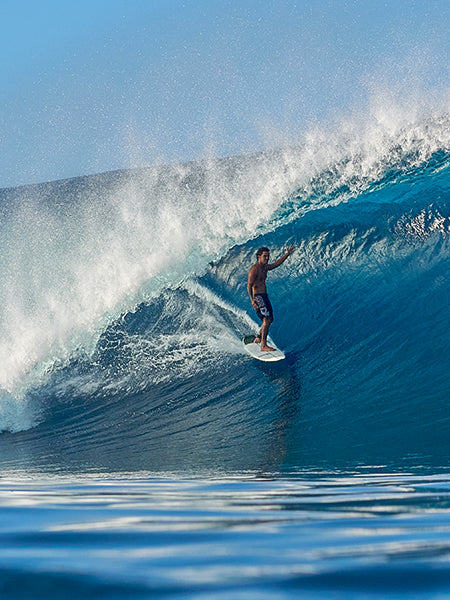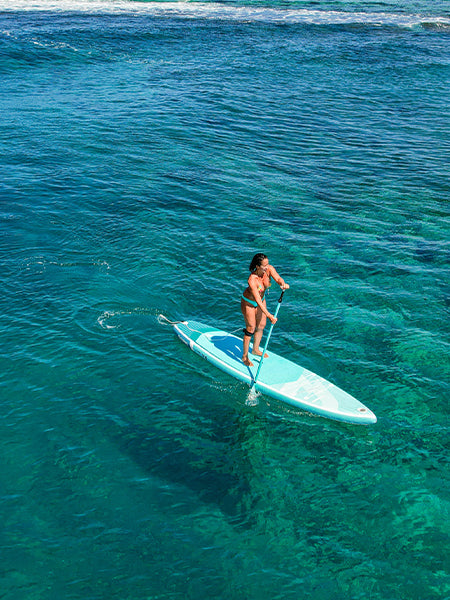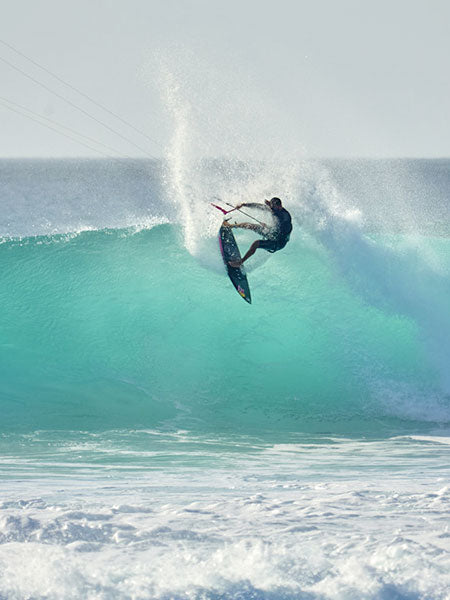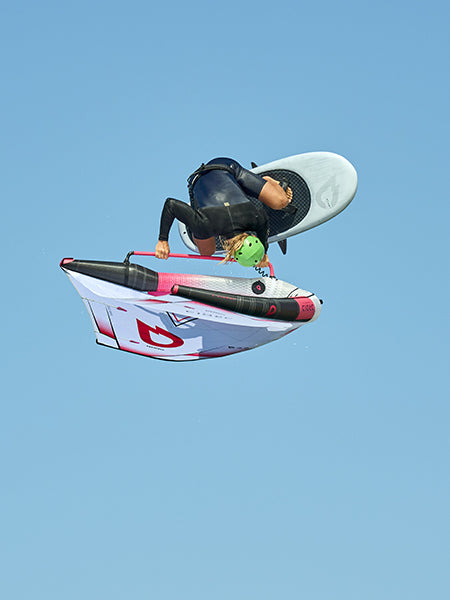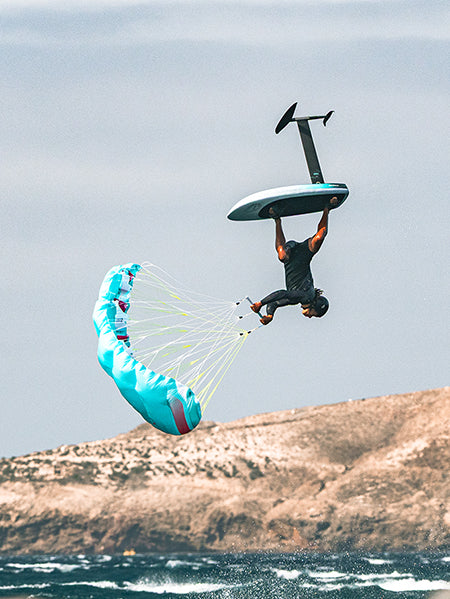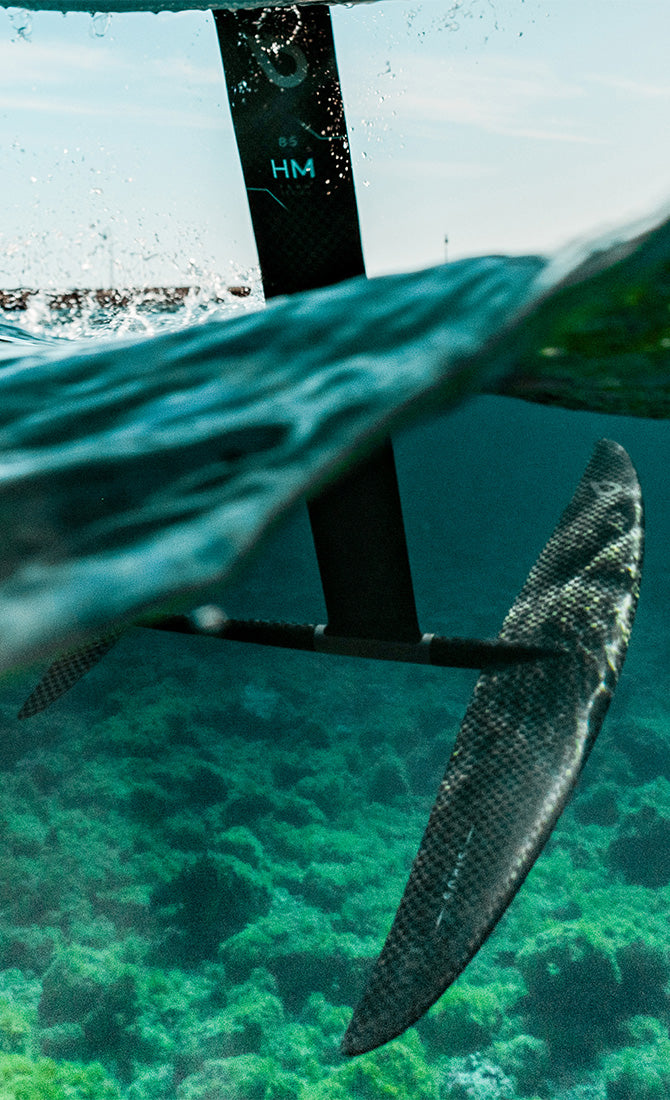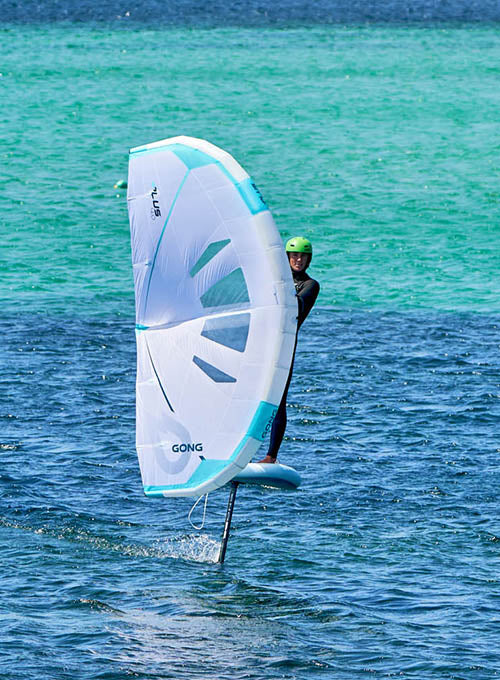Duck jibe to switch
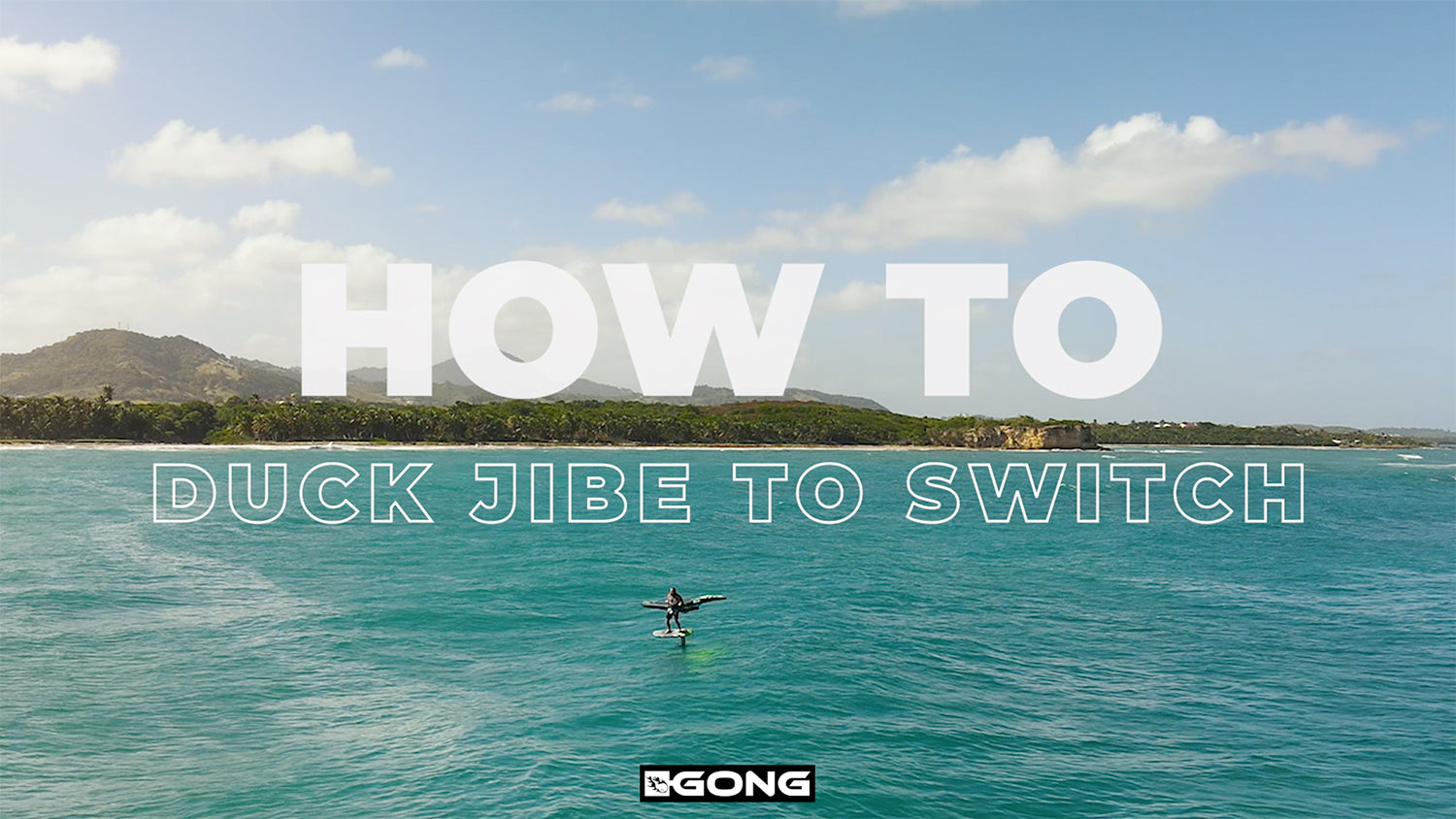
It’s the simplest jibe: you attack the curve in front of the wing to get out from behind. To do a duck jibe to switch, you have to arrive with serious speed; this is an unconditional pre-requisite to get out of the move in flight.
Position of the feet
The simplest way to do this is to take your foot out of the back strap before jibing to place it slightly downwind and prepare the transition from heel to toe support. Take it out of the strap and place it in front of the back strap if there is one.
Strapless, we will move it forward 10cm and shift it downwind on the toe side by 5 to 10cm depending on the radicality of the turn you are planning. The placement of the back foot influences the radicality and stability of your turn. The further back you move it, the shorter and stronger you turn, and the closer you bring it to the rail. Find your personal balance. Tuck your back knee in a little, this will make your trun smoother with less locked support than with the knees apart.
The front foot is in the strap, so naturally in the wind.
Keeping up the speed
We will keep the wing tucked in as we go downwind, to store energy and come out like a flower of the move. Without this boost, the loss of speed in the middle of the move as the wing passes will be such that you will fall back on the water. And then it’s all over, at best you’ll buckle on the water, and you’ll probably fall. Don’t be scared, go hard into the turn. At worst, you’ll fall down lying in the wing. The real danger is the loss of control in a strong deceleration due to lack of commitment. When the foil doesn’t go fast enough, it becomes uncontrollable and that’s when you risk falling on it. So always keep up speed.
Note that over luffing the wing is equivalent to braking, but in jibe this action puts your foil in the water. This is a trick to engage very hard, which is called a racing jibe. And we will keep the wing at 45° at the beginning of the turn while preparing the hand change just before the middle of the turn. So, the front hand is halfway up.
Support transfert
Remember to use the front foot to guide your turn. It supports 50% of your weight, or even more, because even if its job is to carry your weight while the rear foot is driving the curve, in reality it is a good balance and progressive transfers from one to the other that will be the key to the magnificent jibes you will do. The famous support transfer.
Once we start to move towards the wind axis (towards the downwind) we will try to hold the foil in the water by a front foot pressure while keeping the angle of heel with the back foot. We will progressively transfer the support from a lift on the wing to a support on the foil. That is to say that you will carry yourself less with your arms and more with your legs. As you get closer to the wind axis, you will lose traction and you will have to lighten the board by sliding the foil as much as possible. You have to be gentle so as not to create breakage, and firm to accentuate the angle grip.
Change of hands
Arriving close to the wind axis, you have to continue the turn and prepare the change of hands. During this change, you will not have any traction from the wing. So, all your weight will be on the foil. If you have no speed at this moment of the move, it’s game over: you reposition and you have a good chance to lose your balance. So, the solution is to tighten the turn up more and more as you get closer to the wind axis. And as soon as you let go of the wing to change hands, you slide the foil, mainly by dosing the supports; the time it takes to get back on the wing.
Beginners will put too much back foot in this phase, often due to lack of speed and engagement. The other solution is to close the curve violently but it is more complicated.
So, the higher your base speed, the easier it is. And the tighter your curve, the easier it is (without excess).
When you get that, you realize you have plenty of time to change hands on the Wing.
It’s time to change hands :
- My front hand lets go of the handle and comes to grab the handle behind the back hand, or, the back of the handle where your back hand is. For a clean swing of the wing, the front hand always goes behind the back hand.
- The front hand releases the handle and the wing falls. Its leading edge is heavy enough to make the tilt very natural.
- My ex back hand slides along the center strut to naturally catch the front full power handle. Usually you can take your hand off the strut, but at the beginning the ideal is really to slide your hand over the big section of the strut.
- As soon as the new front hand holds the handle, it will mount this handle above the back hand to put the wing in the correct angle and not let it go under the board. For a smoother movement, it is even the back hand that will go down rather than the front hand that will go up. This new rear hand will describe a 180° arc upwards to accompany the tilt of the wing in its new ideal position.
During this hand change phase, you will rotate your torso 90° downwind on the heel side of your body to accompany the hand change. In this way, you will not have your back to the wing on the new tack, but you will be twisted. Ideally you will slightly back the wing from the vertical of the nose to the new leeward rail (toe side) to prepare the relaunch.
Continue the curve and prepare to switch
The next step is to continue the curve by luffing on the new tack, using a heavy foot in support once you have passed the wind axis, and thus relaunching the foil. This is when we will start to hang on the wing again. The hands are well in place, the curve ends, and we can prepare to switch.
You put a pumping in with the back foot, and you can help yourself by tucking the wing in like an umbrella. As soon as you feel the lightness: throw the back foot into the front strap into the wind. The big toe of the back foot should aim at the big toe of the front foot from the inside of the strap. This is the trick to avoid hurting your toes when shooting for the strap. When the big toe of the back foot touches the big toe of the front foot, it gives the big toe of the back foot the heads up to go where the back foot was: just in front of the back strap. Your new back foot corrects all the balance problems of the Board, laterally and longitudinally to avoid touching the water. This switch is done in less than half a second, really!
Remember that switching is not just changing the front and back supports. Yes, your feet are reversing longitudinally, but the most important thing is to steer the port starboard reversal. Your two feet will each produce an effort on either side of the board, and they have to cancel each other out in perfect balance. And the longer your foil mast is, the more margin and therefore time you have to correct these pressure transfers.
The end of the switch
At the end of the switch we will try to get some traction from the wing, but we can also use the foil and its lift by pumping a few strokes.
The key to the relaunch is to lower the front hand to put the wing back on the screen, facing you as fast as possible. So, the more you reduce the hang glide between your arms after the wind has passed, the faster you will go back.
The last phase consists of tucking and tilting the foil into the wind to regain support against the traction of the wing. You will place the back foot in the strap and lean on the heels and fix the new trajectory, taking care not to touch the water again. The body will lean more and more into the wind as you tuck in. Remember to manage the power of the wing because often you will reach the end of your initial speed and you will have to re-launch the wing frankly.
Help yourself by lofting purposefully if you need it , by going upwind at the exit of the jibe you will generate an apparent excess of wind and re-launch your wing.
Key points
- Having speed.
- Use the swell and chop to maintain speed.
- Manage your weight transfer well.
- Have an automated and clean hand movement.
Focus
- Speed.
- Trim and draft shield.
- Curve.
- Changing hands.
- Lightening.
- Tighten the curve.
- Relancer.
- Oppose.
- Switch.
